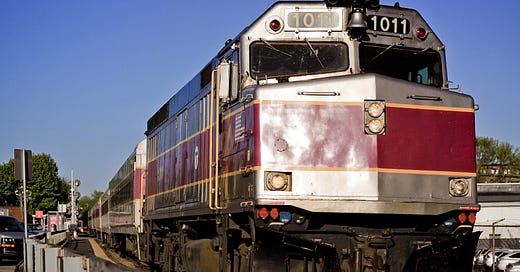
In January 2022, the MBTA released a list of proposed fare changes intended to increase equitable access to the T. While there are many strong proposals included in their plan, the MBTA has overlooked the 16% of Boston residents [1] who lack access to affordable rail service.
Currently, residents of Boston’s Hyde Park, Roslindale, and West Roxbury neighborhoods must pay almost three times more than their fellow Bostonians to ride the train because their neighborhoods are not serviced by subway or light rail stops. Instead, residents have two transit choices: high-priced rides on the commuter rail or slow-moving buses that often get stuck in Boston’s notorious rush-hour traffic.
Unlike the subway and light rail lines within the MBTA, the commuter rail is priced depending on distance. Generally, the farther a station is from its terminal at North or South Station, the more expensive it is to travel from A to B. According to the MBTA, commuter rail stations within metro Boston fall within Zone 1A - the inner-wrung of the commuter rail pricing map. Traveling between any of these stations and downtown costs $2.40 per rider (the current price of a ride on the subway and light rail lines). And while passengers traveling to Fairmount Station in Hyde Park benefit from this subway-level fare, those traveling to Hyde Park Station, just an eight-minute walk away, must pay $6.50 for the same ride.
Travelers to Readville, Roslindale Village, West Roxbury, Highland, and Bellevue Stations also encounter this fare problem. Despite residing within Boston’s city limits and less than 10 miles from the city center, these stops are categorized within Zones 1 and 2 which lie outside the affordable Zone 1A designation.
The current pricing system makes no sense. Why should Boston residents who lack access to subway and light rail lines pay nearly three times more than their fellow Bostonians for a ride into downtown? This is especially baffling because the Red, Blue, Green, and Orange lines all service cities and towns beyond Boston’s borders. Therefore, residents of Malden, Revere, Brookline, Newton, Somerville, Cambridge, Quincy, and Braintree all have access to affordable rail service, while folks in Hyde Park, Roslindale, and West Roxbury must either spend exorbitant amounts of time riding the bus or pay the high price of $6.50 per ride on their local line.
By excluding Hyde Park, Readville, Roslindale Village, West Roxbury, Highland, and Bellevue Stations from Zone 1A, the MBTA also exacerbates an existing environmental justice problem. Hyde Park and Roslindale are low-income neighborhoods with large populations of people of color and non-English speaking residents. These communities are classified as environmental justice neighborhoods because, historically, low-income neighborhoods and communities of color are targeted as dumping grounds for toxic waste and pollution from industrial facilities. By sending diesel-burning commuter trains through these neighborhoods while keeping the prices unaffordable to residents, the MBTA perpetuates this problem and deepens inequity.
Furthermore, public transit is an important tool in the fight against climate change. However, charging people $13 daily to ride the train within their own city significantly limits ridership. Since Fairmount Station was designated as Zone 1A in 2012, ridership has tripled on that line. Similarly, lowering the price for commuters in Roslindale, West Roxbury, and the rest of Hyde Park would likely incentivize significantly higher ridership. This could offset pollution, reduce reliance on cars, and promote environmental sustainability in the city of Boston.
Though critics might claim that the proposed stations are too far from the city’s center to qualify for Zone 1A, the zone’s radius remains undefined. This is evident in the fact that Fairmount Station, currently within Zone 1A, is 8.2 miles away from South Station. However, Bellevue, Highland, West Roxbury, and Hyde Park stations are all within 8 miles of South Station, meaning that they are just as close, if not closer, to the city center. While Readville Station is 9.4 miles away from its terminal, it is dubbed an environmental justice neighborhood. And just like their neighbors, Readville residents deserve an affordable rail option.
As a Hyde Park resident myself, I am grateful to live within walking distance of Fairmount Station, but my neighbors throughout Hyde Park, along with those in Roslindale and West Roxbury, also deserve affordable rail access. As the MBTA seeks to implement equity-forward fare changes, now is the perfect time to ensure that the existing rail infrastructure serves significantly more Bostonians. By including all of Boston’s commuter rail stations in Zone 1A, the MBTA can expand equity, combat climate change, and increase ridership.
[1] Calculated as the number of residents living in Boston neighborhoods not serviced by subway and light rail lines as a percent of Boston’s total population.




